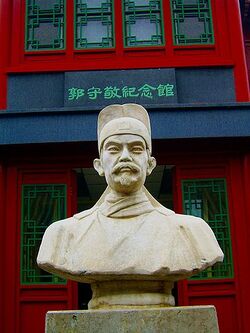Guo Shoujing (nonfiction): Difference between revisions
(Created page with "250px|thumb|Guo Shoujing.'''Guo Shoujing''' (Chinese: 郭守敬, 1231–1316), courtesy name Ruosi (若思), was a Chinese astronomer, engineer, and...") |
|||
| (4 intermediate revisions by the same user not shown) | |||
| Line 1: | Line 1: | ||
[[File:Guo_Shoujing.jpg|250px|thumb|Guo Shoujing.]]'''Guo Shoujing''' (Chinese: 郭守敬, 1231–1316), courtesy name Ruosi (若思), was a Chinese astronomer, engineer, and [[mathematician (nonfiction)]] born in Xingtai, Hebei who lived during the Yuan Dynasty (1271–1368). | [[File:Guo_Shoujing.jpg|250px|thumb|Guo Shoujing.]]'''Guo Shoujing''' (Chinese: 郭守敬, 1231–1316), courtesy name Ruosi (若思), was a Chinese astronomer, engineer, and [[mathematician (nonfiction)]] born in Xingtai, Hebei who lived during the Yuan Dynasty (1271–1368). | ||
Guo Shoujing was a child prodigy, showing exceptional promise. By his teens, he obtained a blueprint for a water clock which his grandfather was working on, and realized its principles of operation. He improved the design of a type of water clock called a lotus clepsydra, a water clock with a bowl shaped like a lotus flower on the top into which the water dripped. | |||
At 20, Guo became a hydraulic engineer, in time becoming the chief advisor of hydraulics, mathematics, and astronomy for Kublai Khan. | |||
Guo began to construct astronomical observation devices. He has been credited with inventing the [[gnomon (nonfiction)]], the square table, the abridged or simplified armilla, and a water powered armillary sphere called the Ling Long Yi. | |||
The gnomon is used to measure the angle of the sun, determine the seasons, and is the basis of the sundial, but Guo Shoujing revised this device to become much more accurate and improved the ability to tell time more precisely. | |||
Guo Shoujing and his colleagues built 27 observatories throughout China in order to gain thorough observations for their calculations. | |||
His year of death is variously reported as 1314 or 1316. | |||
== In the News == | == In the News == | ||
<gallery mode="traditional"> | <gallery mode="traditional"> | ||
File:Ecliptic path.jpg|link=Zodiac Healer|The [[Zodiac Healer]] travels along the ecliptic, exactly as Guo Shoujing predicted. | |||
File:Guo_Shoujing_studies_the_Pleiades.jpg|Guo Shoujing studies the Pleiades, discovers new form of [[Gnomon algorithm]]. | |||
</gallery> | </gallery> | ||
| Line 19: | Line 33: | ||
[[Category:Nonfiction (nonfiction)]] | [[Category:Nonfiction (nonfiction)]] | ||
[[Category:Astronomers (nonfiction)]] | |||
[[Category:Mathematicians (nonfiction)]] | [[Category:Mathematicians (nonfiction)]] | ||
[[Category:People (nonfiction)]] | [[Category:People (nonfiction)]] | ||
Latest revision as of 18:44, 5 December 2016
Guo Shoujing (Chinese: 郭守敬, 1231–1316), courtesy name Ruosi (若思), was a Chinese astronomer, engineer, and mathematician (nonfiction) born in Xingtai, Hebei who lived during the Yuan Dynasty (1271–1368).
Guo Shoujing was a child prodigy, showing exceptional promise. By his teens, he obtained a blueprint for a water clock which his grandfather was working on, and realized its principles of operation. He improved the design of a type of water clock called a lotus clepsydra, a water clock with a bowl shaped like a lotus flower on the top into which the water dripped.
At 20, Guo became a hydraulic engineer, in time becoming the chief advisor of hydraulics, mathematics, and astronomy for Kublai Khan.
Guo began to construct astronomical observation devices. He has been credited with inventing the gnomon (nonfiction), the square table, the abridged or simplified armilla, and a water powered armillary sphere called the Ling Long Yi.
The gnomon is used to measure the angle of the sun, determine the seasons, and is the basis of the sundial, but Guo Shoujing revised this device to become much more accurate and improved the ability to tell time more precisely.
Guo Shoujing and his colleagues built 27 observatories throughout China in order to gain thorough observations for their calculations.
His year of death is variously reported as 1314 or 1316.
In the News
The Zodiac Healer travels along the ecliptic, exactly as Guo Shoujing predicted.
Guo Shoujing studies the Pleiades, discovers new form of Gnomon algorithm.
Fiction cross-reference
Nonfiction cross-reference
External links:
- Guo Shoujing @ Wikipedia
Attribution:


